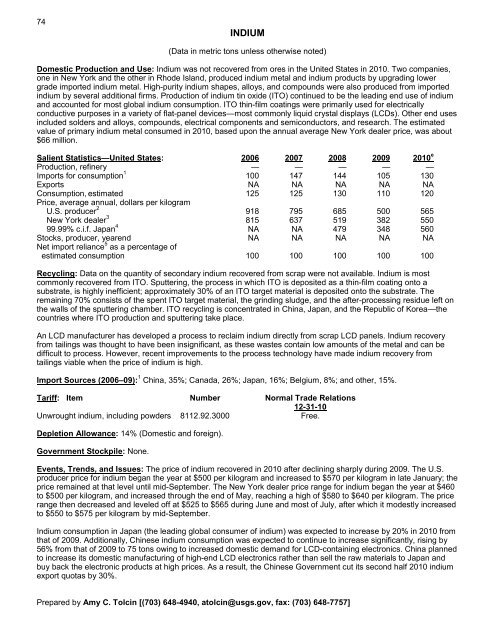HELIUM73Events, Trends, <strong>and</strong> Issues: During 2010, some helium suppliers announced price increases of 5% to 10% inresponse to continued increased raw material, energy, <strong>and</strong> distribution costs. The price of pure helium is expected tocontinue to increase as production costs, including the price of crude helium, increase. The BLM raised the FY <strong>2011</strong>price of open-market crude helium to $2.70 per cubic meter ($75.00 per million cubic feet) based onrecommendations from a report from the National Research Council of the National Academies. During 2010, heliumconsumption increased by about 15% compared with that of 2009. During FY 2010, the AMFO conducted four openmarket helium offerings, selling a total of 59.2 million cubic meters (2,133 million cubic feet). The Skikda, Algeria,helium plant continued to experience operational problems, <strong>and</strong> the plant in Arzew, Algeria, experienced productionproblems related to the liquefied natural gas trains. The Qatar helium plant experienced no major operationalproblems <strong>and</strong> maintained the same rates of production as in 2008 <strong>and</strong> 2009. A new helium plant in Australia startedup in March. Worldwide, eight new helium plant projects were scheduled for startup between <strong>2011</strong> <strong>and</strong> 2017. Twoprojects were scheduled for startup in the United States during <strong>2011</strong>–14 near Riley Ridge, WY, <strong>and</strong> St. Johns, AZ.The other plants were planned for Algeria, China, India, Indonesia, Qatar, <strong>and</strong> Russia.World Production <strong>and</strong> Reserves: Reserves data were revised based on estimated production for 2009 <strong>and</strong> newinformation available from the Government of Pol<strong>and</strong>.Production Reserves 82009 2010 eUnited States (extracted from natural gas) 78 77 4,000United States (from Cliffside Field) 40 48 ( 9 )Algeria 20 18 1,800Canada NA NA NAChina NA NA NAPol<strong>and</strong> 3.3 2.6 33Qatar NA NA NARussia 5.3 5.5 1,700Other countries NA NANAWorld total (rounded) 147 150 NAWorld Resources: As of December 31, 2006, the total helium reserves <strong>and</strong> resources of the United States wereestimated to be 20.6 billion cubic meters (744 billion cubic feet). This includes 4.25 billion cubic meters (153.2 billioncubic feet) of measured reserves, 5.33 billion cubic meters (192.2 billion cubic feet) of probable resources, 5.93 billioncubic meters (213.8 billion cubic feet) of possible resources, <strong>and</strong> 5.11 billion cubic meters (184.4 billion cubic feet) ofspeculative resources. Included in the measured reserves are 0.67 billion cubic meters (24.2 billion cubic feet) ofhelium stored in the Cliffside Field Government Reserve, <strong>and</strong> 0.065 billion cubic meters (2.3 billion cubic feet) ofhelium contained in Cliffside Field native gas. The Hugoton (Kansas, Oklahoma, <strong>and</strong> Texas), Panh<strong>and</strong>le West,Panoma, Riley Ridge, <strong>and</strong> Cliffside Fields are the depleting fields from which most U.S.-produced helium is extracted.These fields contain an estimated 3.9 billion cubic meters (140 billion cubic feet) of helium.Helium resources of the world, exclusive of the United States, were estimated to be about 31.3 billion cubic meters(1.13 trillion cubic feet). The locations <strong>and</strong> volumes of the major deposits, in billion cubic meters, are Qatar, 10.1;Algeria, 8.2; Russia, 6.8; Canada, 2.0; <strong>and</strong> China, 1.1. As of December 31, 2010, AMFO had analyzed about 22,000gas samples from 26 countries <strong>and</strong> the United States, in a program to identify world helium resources.Substitutes: There is no substitute for helium in cryogenic applications if temperatures below –429° F are required.Argon can be substituted for helium in welding, <strong>and</strong> hydrogen can be substituted for helium in some lighter-than-airapplications in which the flammable nature of hydrogen is not objectionable. Hydrogen is also being investigated as asubstitute for helium in deep-sea diving applications below 1,000 feet.e Estimated. E Net exporter. NA Not available. — Zero.1 Measured at 101.325 kilopascals absolute (14.696 psia) <strong>and</strong> 15° C; 27.737 cubic meters of helium = 1 Mcf of helium at 70° F <strong>and</strong> 14.7 psia.2 Helium from both Grade-A <strong>and</strong> crude helium.3 Extracted from natural gas in prior years.4 Grade-A helium.5 Defined as imports – exports + adjustments for Government <strong>and</strong> industry stock changes.6 See Appendix B for definitions.7 Team Leader, Resources <strong>and</strong> Evaluation Group, Bureau of L<strong>and</strong> Management, Amarillo Field Office, Helium Operations, Amarillo, TX.8 See Appendix C for resource/reserve definitions <strong>and</strong> information concerning data sources.9 Included in United States (extracted from natural gas) reserves.U.S. Geological Survey, <strong>Mineral</strong> <strong>Commodity</strong> <strong>Summaries</strong>, January <strong>2011</strong>
74INDIUM(Data in metric tons unless otherwise noted)Domestic Production <strong>and</strong> Use: Indium was not recovered from ores in the United States in 2010. Two companies,one in New York <strong>and</strong> the other in Rhode Isl<strong>and</strong>, produced indium metal <strong>and</strong> indium products by upgrading lowergrade imported indium metal. High-purity indium shapes, alloys, <strong>and</strong> compounds were also produced from importedindium by several additional firms. Production of indium tin oxide (ITO) continued to be the leading end use of indium<strong>and</strong> accounted for most global indium consumption. ITO thin-film coatings were primarily used for electricallyconductive purposes in a variety of flat-panel devices—most commonly liquid crystal displays (LCDs). Other end usesincluded solders <strong>and</strong> alloys, compounds, electrical components <strong>and</strong> semiconductors, <strong>and</strong> research. The estimatedvalue of primary indium metal consumed in 2010, based upon the annual average New York dealer price, was about$66 million.Salient Statistics—United States: 2006 2007 2008 2009 2010 eProduction, refinery — — — — —Imports for consumption 1 100 147 144 105 130Exports NA NA NA NA NAConsumption, estimated 125 125 130 110 120Price, average annual, dollars per kilogramU.S. producer 2 918 795 685 500 565New York dealer 3 815 637 519 382 55099.99% c.i.f. Japan 4 NA NA 479 348 560Stocks, producer, yearend NA NA NA NA NANet import reliance 5 as a percentage ofestimated consumption 100 100 100 100 100Recycling: Data on the quantity of secondary indium recovered from scrap were not available. Indium is mostcommonly recovered from ITO. Sputtering, the process in which ITO is deposited as a thin-film coating onto asubstrate, is highly inefficient; approximately 30% of an ITO target material is deposited onto the substrate. Theremaining 70% consists of the spent ITO target material, the grinding sludge, <strong>and</strong> the after-processing residue left onthe walls of the sputtering chamber. ITO recycling is concentrated in China, Japan, <strong>and</strong> the Republic of Korea—thecountries where ITO production <strong>and</strong> sputtering take place.An LCD manufacturer has developed a process to reclaim indium directly from scrap LCD panels. Indium recoveryfrom tailings was thought to have been insignificant, as these wastes contain low amounts of the metal <strong>and</strong> can bedifficult to process. However, recent improvements to the process technology have made indium recovery fromtailings viable when the price of indium is high.Import Sources (2006–09): 1 China, 35%; Canada, 26%; Japan, 16%; Belgium, 8%; <strong>and</strong> other, 15%.Tariff: Item Number Normal Trade Relations12-31-10Unwrought indium, including powders 8112.92.3000 Free.Depletion Allowance: 14% (Domestic <strong>and</strong> foreign).Government Stockpile: None.Events, Trends, <strong>and</strong> Issues: The price of indium recovered in 2010 after declining sharply during 2009. The U.S.producer price for indium began the year at $500 per kilogram <strong>and</strong> increased to $570 per kilogram in late January; theprice remained at that level until mid-September. The New York dealer price range for indium began the year at $460to $500 per kilogram, <strong>and</strong> increased through the end of May, reaching a high of $580 to $640 per kilogram. The pricerange then decreased <strong>and</strong> leveled off at $525 to $565 during June <strong>and</strong> most of July, after which it modestly increasedto $550 to $575 per kilogram by mid-September.Indium consumption in Japan (the leading global consumer of indium) was expected to increase by 20% in 2010 fromthat of 2009. Additionally, Chinese indium consumption was expected to continue to increase significantly, rising by56% from that of 2009 to 75 tons owing to increased domestic dem<strong>and</strong> for LCD-containing electronics. China plannedto increase its domestic manufacturing of high-end LCD electronics rather than sell the raw materials to Japan <strong>and</strong>buy back the electronic products at high prices. As a result, the Chinese Government cut its second half 2010 indiumexport quotas by 30%.Prepared by Amy C. Tolcin [(703) 648-4940, atolcin@usgs.gov, fax: (703) 648-7757]
- Page 3:
U.S. Department of the InteriorKEN
- Page 6 and 7:
INTRODUCTION3Each chapter of the 20
- Page 8 and 9:
5NET EXPORTS OF MINERALRAW MATERIAL
- Page 10 and 11:
SIGNIFICANT EVENTS, TRENDS, AND ISS
- Page 12 and 13:
mineral materials valued at $1.30 b
- Page 14 and 15:
11MAJOR METAL-PRODUCING AREASAuB2P1
- Page 16 and 17:
13MAJOR INDUSTRIAL MINERAL-PRODUCIN
- Page 18 and 19:
ABRASIVES (MANUFACTURED)15Events, T
- Page 20 and 21:
ALUMINUM17The United States continu
- Page 22 and 23:
ANTIMONY19Events, Trends, and Issue
- Page 24 and 25:
ARSENIC21According to university me
- Page 26 and 27: ASBESTOS23Events, Trends, and Issue
- Page 28 and 29: BARITE25Nationally, the rig count o
- Page 30 and 31: BAUXITE AND ALUMINA27Events, Trends
- Page 32 and 33: BERYLLIUM29Events, Trends, and Issu
- Page 34 and 35: BISMUTH31Events, Trends, and Issues
- Page 36 and 37: BORON33Events, Trends, and Issues:
- Page 38 and 39: BROMINE35Events, Trends, and Issues
- Page 40 and 41: CADMIUM37NiCd battery use in consum
- Page 42 and 43: CEMENT39The manufacture of clinker
- Page 44 and 45: CESIUM41Events, Trends, and Issues:
- Page 46 and 47: CHROMIUM43Stockpile Status—9-30-1
- Page 48 and 49: CLAYS45Tariff: Item Number Normal T
- Page 50 and 51: COBALT47Events, Trends, and Issues:
- Page 52 and 53: COPPER49Events, Trends, and Issues:
- Page 54 and 55: DIAMOND (INDUSTRIAL)51Events, Trend
- Page 56 and 57: DIATOMITE53Events, Trends, and Issu
- Page 58 and 59: FELDSPAR55Feldspar use in tile and
- Page 60 and 61: FLUORSPAR57with planned output of 1
- Page 62 and 63: GALLIUM59In response to the unprece
- Page 64 and 65: GARNET (INDUSTRIAL)61Events, Trends
- Page 66 and 67: GEMSTONES63Events, Trends, and Issu
- Page 68 and 69: GERMANIUM65Events, Trends, and Issu
- Page 70 and 71: GOLD67With the increase in price of
- Page 72 and 73: GRAPHITE (NATURAL)69Events, Trends,
- Page 74 and 75: GYPSUM71Through 2010, more than 3,6
- Page 78 and 79: INDIUM75China’s 21 indium produce
- Page 80 and 81: IODINE77Events, Trends, and Issues:
- Page 82 and 83: IRON AND STEEL79Events, Trends, and
- Page 84 and 85: IRON AND STEEL SCRAP81Tariff: Item
- Page 86 and 87: IRON AND STEEL SLAG83Events, Trends
- Page 88 and 89: IRON ORE85In 2009, China imported a
- Page 90 and 91: IRON OXIDE PIGMENTS87Events, Trends
- Page 92 and 93: KYANITE AND RELATED MATERIALS89Even
- Page 94 and 95: LEAD91caused by underground fires a
- Page 96 and 97: LIME93The lime industry is facing p
- Page 98 and 99: LITHIUM95market, and a facility at
- Page 100 and 101: MAGNESIUM COMPOUNDS97In Australia,
- Page 102 and 103: MAGNESIUM METAL99U.S. magnesium con
- Page 104 and 105: MANGANESE101Government Stockpile:St
- Page 106 and 107: MERCURY103Events, Trends, and Issue
- Page 108 and 109: MICA (NATURAL)105Depletion Allowanc
- Page 110 and 111: MOLYBDENUM107Events, Trends, and Is
- Page 112 and 113: NICKEL109Nickel prices were adverse
- Page 114 and 115: NIOBIUM (COLUMBIUM)111Events, Trend
- Page 116 and 117: NITROGEN (FIXED)—AMMONIA113Accord
- Page 118 and 119: PEAT115Events, Trends, and Issues:
- Page 120 and 121: PERLITE117Events, Trends, and Issue
- Page 122 and 123: PHOSPHATE ROCK119Events, Trends, an
- Page 124 and 125: PLATINUM-GROUP METALS121Events, Tre
- Page 126 and 127:
POTASH123Events, Trends, and Issues
- Page 128 and 129:
PUMICE AND PUMICITE125Events, Trend
- Page 130 and 131:
QUARTZ CRYSTAL (INDUSTRIAL)127Event
- Page 132 and 133:
RARE EARTHS129Events, Trends, and I
- Page 134 and 135:
RHENIUM131Events, Trends, and Issue
- Page 136 and 137:
RUBIDIUM133Events, Trends, and Issu
- Page 138 and 139:
SALT135Many chefs have advocated us
- Page 140 and 141:
SAND AND GRAVEL (CONSTRUCTION)137Ev
- Page 142 and 143:
SAND AND GRAVEL (INDUSTRIAL)139The
- Page 144 and 145:
SCANDIUM141Scandium’s use in meta
- Page 146 and 147:
SELENIUM143Events, Trends, and Issu
- Page 148 and 149:
SILICON145Events, Trends, and Issue
- Page 150 and 151:
SILVER147Silver was used as a repla
- Page 152 and 153:
SODA ASH149A Wyoming soda ash produ
- Page 154 and 155:
SODIUM SULFATE151Events, Trends, an
- Page 156 and 157:
STONE (CRUSHED)153Events, Trends, a
- Page 158 and 159:
STONE (DIMENSION)155Events, Trends,
- Page 160 and 161:
STRONTIUM157Events, Trends, and Iss
- Page 162 and 163:
SULFUR159World sulfur production in
- Page 164 and 165:
TALC AND PYROPHYLLITE161Events, Tre
- Page 166 and 167:
TANTALUM163Events, Trends, and Issu
- Page 168 and 169:
TELLURIUM165Events, Trends, and Iss
- Page 170:
THALLIUM167Beginning in 2009, there
- Page 173 and 174:
170TIN(Data in metric tons of tin c
- Page 175 and 176:
172TITANIUM AND TITANIUM DIOXIDE 1(
- Page 177 and 178:
174TITANIUM MINERAL CONCENTRATES 1(
- Page 179 and 180:
176TUNGSTEN(Data in metric tons of
- Page 181 and 182:
178VANADIUM(Data in metric tons of
- Page 183 and 184:
180VERMICULITE(Data in thousand met
- Page 185 and 186:
182WOLLASTONITE(Data in metric tons
- Page 187 and 188:
184YTTRIUM 1(Data in metric tons of
- Page 189 and 190:
186ZEOLITES (NATURAL)(Data in metri
- Page 191 and 192:
188ZINC(Data in thousand metric ton
- Page 193 and 194:
190ZIRCONIUM AND HAFNIUM(Data in me
- Page 195 and 196:
192APPENDIX AAbbreviations and Unit
- Page 197 and 198:
194Demonstrated.—A term for the s
- Page 199 and 200:
196Part B—Sources of Reserves Dat
- Page 201:
198Europe and Central Eurasia—con







